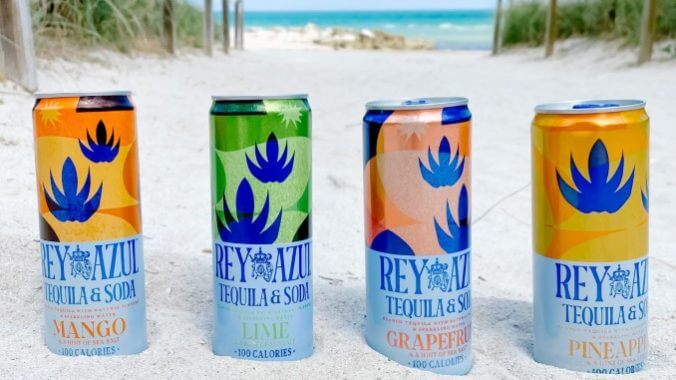Tasting: 4 Tequila Sodas From Rey Azul
Photos via Mark Anthony Brands
In the rapidly exploited world of ready-to-drink cocktails, henceforth referred to here as simply the “RTD” field, the biggest ideological divide is between the use of actual spirits, and the use of alcohol derived from malt fermentation. In the eyes of the government and consumers, the latter basically implies hard seltzers, the vast majority of which are technically classified as beer because they’re using alcohol derived from the fermentation of malt sugars, exactly as you’d find in any beer. For the last few years the push-and-pull in the market, then, has been between bargain-priced “mixed drink” brands trying to approximate (or outright fake) the flavors of spirits by using alcohol derived from malt, and higher-priced, premiumized brands using real spirits to make drinks closer to what you’d actually order in a bar. The result has in many instances been a deluge of terrible drinks, occasionally broken up by quality products piercing through the noise.
The Mark Anthony Group knows all about both sides of this market. The makers of monolithic, style-defining brands such as White Claw and Mike’s Hard Lemonade, they also own spirits distilleries, wineries and more. They clearly want a taste of all sides of this equation—thus, they own and operate a company like MXD Drinks Co., which makes fake cocktails (mai tais, daiquiris, etc) with alcohol derived from malt, while also launching the new Rey Azul Tequila & Soda line to make canned, RTD cocktails with actual, distilled spirits. Essentially, they’re throwing everything at the wall and seeing what will stick, in terms of consumer impact.
The new Rey Azul line comes in four flavors, and boasts that it is made with “authentic premium blanco tequila using blue agave grown in Jalisco, Mexico and produced in partnership with a second generation family-owned agave farm and distillery.” This tequila is paired with the ubiquitous “natural flavors” and “a hint of sea salt” to complete the image of fuss-free, basic tequila cocktails that weigh in at a standard 5% ABV, and 100 calories. As is almost always the case in these brands, the idea is that you can simply have an idea of what you’re getting at a glance, without having to think too much about it.
In reality, though, there is of course more to consider. Nowhere, for instance, on the Rey Azul marketing materials or cans does it state the product was made with 100% blue agave tequila, which immediately made me suspect that Mark Anthony Group, as a major player in the market looking to cut cost, was likely using cheaper “mixto” tequila, derived from a combination of agave fermentation and other fermentable sugars. This, the company confirmed to me when I inquired, though they at least noted that the company does not use the industry villain of diffusor-extracted agave sugars. As a company representative put it:
Rey Azul is a mixto tequila, but quite different from others on the market. Unlike many mixto tequilas, Rey Azul is made traditionally, without the use of diffusers and is additive-free. There are no column stills used in the making of Rey Azul. Instead, the blue agave is slow cooked in a brick oven for 30+ hours, distilled in a pot still and then a Coffey still. This small batch process delivers tequila with incredible depth of flavor and a smooth finish.
It’s hard to know quite what to make of that sort of statement, given basic facts such as the fact that a Coffey still is a column still by definition, but it is what it is. We’re looking at a lineup here of affordably priced, accessible canned cocktails, each of which says they feature fruit “flavor,” rather than say, actual fruit juice. This is simply the reality of the alcohol market as it exists today.
So with that said, let’s get to tasting and see if any of these can rise above their limitations.
Rey Azul Tequila & Soda Lime

As with all of these entries, the company states that Rey Azula Tequila & Soda Lime is made with blanco tequila, “lime taste” and “just a hint of sea salt.” The company recommends consuming over ice, or straight from the can. I tasted all of these expressions over ice. All weigh in at 5% ABV, are gluten free, and contain 100 calories.
Rey Azul Lime is actually nicely full of tequila character on the nose, more so than any of the other expressions. The lime is more subtle than some of the other flavorings, at least aromatically, which allows traces of herbal and peppery tequila to take center stage. On the palate, though, the profile turns oddly fruity, with a distracting, watermelon and berry-like character that can’t help but read as artificial. It does contain the slightly spicy and herbal tequila notes, and those notes are its saving grace. The drink is thankfully only mildly sweet, taking clear inspiration from the relative dryness of hard seltzers, but little about the fruitiness here is actually reminiscent of lime juice.
The bottom line is that this could absolutely be worse, but it would also be so easy to do better, by simply making your own tequila and soda with a splash of lime juice. And personally, I care enough about my drinks that this is almost always the superior option for me.
Rey Azula Tequila & Soda Mango
Whereas the lime flavor of Rey Azul is at least somewhat subtle in its delivery, the more assertive Mango (and the Pineapple, unsurprisingly) are far more direct. That will be a good thing for some consumers, and a bad thing for others.
I must say, on the nose the Mango is actually pretty inviting—the natural flavor whizzes have this smelling intensely of juicy mango, and the tropical waft of it is pretty pleasant. What you’re not getting on the nose is tequila, which has been deftly covered up by the fruitiness.
On the palate, the mango is big and bold, reading as candy sweet even though there’s not a ton of residual sugar. It’s a bit bubblegum-like, but the mango is more authentic and identifiable in flavor than the lime was on the previous can. The tequila is unsurprisingly largely lost in the shuffle, but this can makes me wonder if I might react differently to this drink if it tasted this way because it was made with actual mangos. The experience is like the flavor of mango chunks in heavy syrup, and at the end of the day I think that’s an okay thing—one that consumers will probably enjoy, even if my brain struggles to process it.
Rey Azul Tequila & Soda Grapefruit

The Grapefruit flavor of Rey Azul is where the brand finds its most deft balance between flavoring and the modestly characterful base spirit, while also getting the most mileage from the relatively unheralded addition of salt. All in all, I found this to be the best and most balanced of the expressions, and the one I would be most likely to enjoy at the beach, or poolside, in the spirit it was intended.
The nose here is inviting in a more subtle way—as someone who drinks a lot of grapefruit seltzer on a daily basis, it’s pretty reminiscent of my go-tos, albeit with a moderate amount of herbaceous and peppery tequila character poking through. The tequila here is a little less expressive than on the Lime, but it’s balanced with the assertiveness of the grapefruit.
On the palate, this is much the same—more subtle, and more balanced, less likely to read as artificial in some way. The tequila shines through nicely, and the salt in this expression is significantly more noticeable, or perhaps the salinity just pairs well with the slightly savory grapefruit. Only a hint of medicinal character detracts from this, but all in all this flavor is easily the winner of the group.
Rey Azul Tequila & Soda Pineapple
Well, there’s no missing that this is the pineapple expression, I can tell you that. I’m getting no tequila at all on the nose of this guy—it’s like opening a tiny can of Dole pineapple juice, slightly metallic tint and all.
The palate is much the same—heavy pineapple flavor, and very juicy, but also simultaneously thin and metallic in a way that is off-putting. The sweetness here also has a quality that I’d compare to the likes of the aspartame in a can of Diet Coke, which is confusing to the palate. There’s a definite sense of uncanny valley.
In the end, the most successful of these Rey Azul Tequila & Soda experiments are the expressions that try for at least a bit of subtlety, which generally allows the tequila to become a bigger part of the flavor profile. This makes sense to me—after all, if real tequila is the selling point, then people should want to taste it, right? How these mass-market, spirit-based cocktails will compete with fake cocktails featuring alcohol from malt fermentation remains to be seen, but between the two it’s pretty easy to say that I like these marginally more.
Granted: Would I still prefer to simply mix my own drink with the tequila that I have on hand? That answer is yes, which I don’t expect to change anytime soon.
Jim Vorel is a Paste staff writer and resident beer and liquor geek. You can follow him on Twitter for more food and drink writing.







































